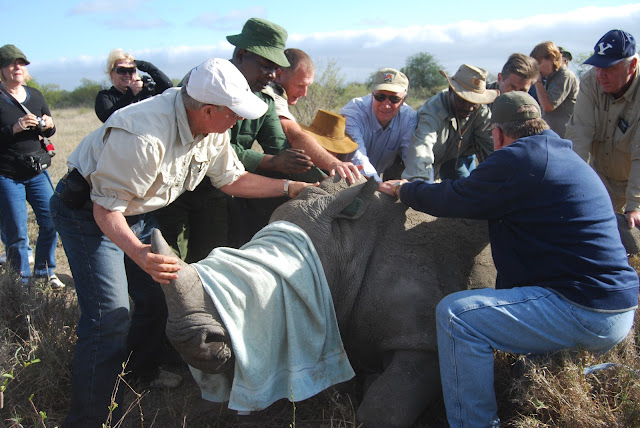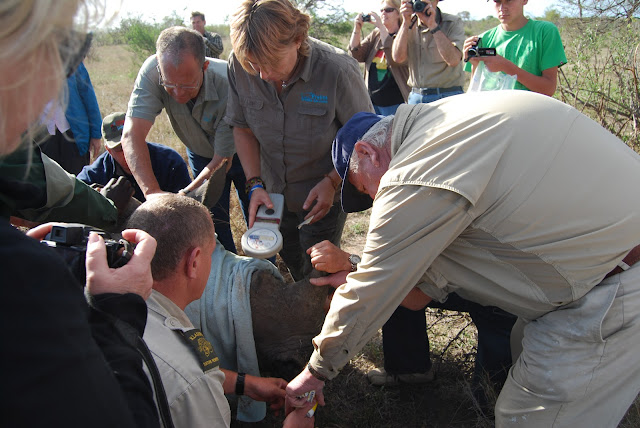October 2
Sean Donnelly (the ASEA Public Affairs Director who I now
serve as a secretary/assistant) invited Dave and myself to go on a “Rhino
Capture” with him, his wife and several other missionary couples. He’s part of a conservation group here
in South Africa who are trying to prevent rhinos from being poached. Hundreds of them are killed every year
(over 400 to date this year)—even in the National Parks and protected
reserves—because their horns are so valuable. In China, Vietnam and other Asian countries, the ground up
horns are considered to be an aphrodesiac and to cure cancer and other
illnesses. Per kilo, it is worth more
than gold or pure heroin on the black market—between $300,000 and $500,000 a
horn. Many people are very poor
here and are willing to risk their lives for that kind of money. It’s so sad—they usually use an axe to
extract the horn and just leave the animal to die.
We were part of an effort to protect them—in an interesting
way. We drove about 6 hours into a
private reserve called Klasseri that connects with the thousands of acres
of Kruger Park.
We spent Saturday on Safari in Kruger
and saw many beautiful animals—lots of elephants, kudu, impala, giraffe, cape
buffalo, jackel, hippo, etc. On
Sunday we had a Sacrament Meeting together with the approval of the Area
Presidency (Dave gave a wonderful talk) and then we were on the road at 5:45 AM
on Monday morning.
This is a black backed jackel
Zebras are like a human fingerprint--no two stripe patterns are alike.
These two hippos were doing a mating dance--it was actually a graceful maneuvering of their mouths for a long period of time in the water.
Out on the
reserve, we met up with the vet, his assistant and the head ranger. While we waited for the helicopter,
they explained what we would be doing and gave assignments to everyone.
The vet and his assistant carefully prepared the tranquilizer darts and other medications.
This is the air rifle used to shoot the tranquilizer dart into the rump of the rhino. Apparently there is one place that is soft enough for the needle to get through the tough skin.
We were all involved—someone had a cloth to cover the rhino’s eyes, someone had some wads of socks to put in the ears, someone had to monitor the number of breaths per minute, someone was assigned to put a special cream in the eyes, etc. Because I had just had a birthday, I got to ride in the helicopter when the vet shot the tranquilizer into the rump of the rhino. First, the helicopter went up and located and identified the rhino they wanted, then he came back to the group and picked up the vet and me. I had borrowed a movie camera so I could film the whole thing—I felt terrible pressure to do that well! What a glorious experience it was for me—just amazing to fly over the vast expanse of Africa and see the animals and endless bush below me.
There were no doors on the helicopter--the sides were just wide open--what a thrill ride!
If you look closely, you can see the dart with a bright pink feather in the one in the center.
The helicopter hearded her a little bit to keep her from going into thick bush--we needed her out in the open where we could work on her.
I jumped out of the helicopter and immediately began filming the safari vehicles racing toward us to get to work.
As the medication began to take effect, she fell down and the vets quickly began stabilizing her.
She went onto her side and the men had to push her upright so that she could breathe better. It took a lot of strength to hold her in that position.
 The vet put an IV into a vein in her ear so they could give her medications. DNA samples were taken, they drilled a hole in each horn and placed trackable microchips in each one (then filled in the holes with glue and a wood plug—you couldn’t even tell where the hole had been). Then they notched her ears in such a way that from the air they could recognize exactly which rhino she is and can keep track of her. She was number 160 to have this procedure done in that particular reserve—though many others have been done elsewhere. She began to shake and quiver a little and I just wanted so badly to comfort her—we all named her Sister Lulu. Her vital signs were being monitored constantly and records were being kept on everything.
The vet put an IV into a vein in her ear so they could give her medications. DNA samples were taken, they drilled a hole in each horn and placed trackable microchips in each one (then filled in the holes with glue and a wood plug—you couldn’t even tell where the hole had been). Then they notched her ears in such a way that from the air they could recognize exactly which rhino she is and can keep track of her. She was number 160 to have this procedure done in that particular reserve—though many others have been done elsewhere. She began to shake and quiver a little and I just wanted so badly to comfort her—we all named her Sister Lulu. Her vital signs were being monitored constantly and records were being kept on everything. They monitored her vital signs continually.
Here they are clamping off the edges of the newly notched ear. They have a unique way of numbering them with the notches and can identify each one. Below you can see the notch clearly. That is Dave in the foreground taking the surgical clamps off.
She's beginning to come around!
Struggling to get on her feet!
She takes off to find her family--
Turns to us and nods as if to say "good-bye and thank you"--
And then takes off into the bush!
The tracking devices have been a big deterrent to the poachers to this date in the areas where they have been implemented-- and our efforts might just protect her from losing her life. We sure hope so! We feel very attached to one sweet African rhino--our dear little "Sister Lulu."

























No comments:
Post a Comment